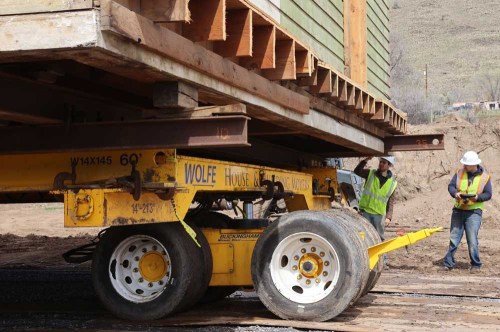Warm Springs is turning a 126-year-old building into a home for inspiration
Published 5:00 am Tuesday, April 5, 2022

- From left, Dallas Deaton and Nevin Buckingham with Wolfe House & Building Movers use remote controls to maneuver the 126-year old commissary building into its new location Monday near U.S. Highway 26 in Warm Springs.
A business incubator project at Warm Springs is on the move — quite literally.
The building that will house the incubator project was physically lifted off its foundation and moved on Monday to a more prominent place, adjacent to U.S. Highway 26. Project organizers hope that the more visible location will entice drivers to veer off the highway and use its services.
Trending
The incubator project, still in development stages, is expected to house a number of locally owned and operated services that could include a cafe, shops, commercial kitchen or artist space for local makers.
The Warm Springs Indian Reservation suffers from high rates of unemployment, and poverty and the business incubator project is expected to help local entrepreneurs to kick start their businesses and hire workers.
Poverty on the reservation is estimated to be around 24%, according to the Warm Springs Community Action Team, the nonprofit that is developing the business incubator. The team says that when it’s fully up and running in two years, the incubator will employ around 25 people.
The building that will house the incubator is the oldest existing structure on the reservation. Built in 1896, it served mainly as the reservation’s commissary, the place where Warm Springs residents once lined up to receive U.S. government rations of flour, grain and other commodities and supplies. From the late 1960s into the 1990s it served as the Warm Springs Natural Resources Department.
For some Warm Springs residents, the commissary is viewed as a symbol of Native American dependence on the U.S. government, said Dustin Seyler, the Community Action Team’s small-business program manager.
“It symbolizes the loss of control of our food system and economy because the commodity foods provided there helped ensure we did not regain traditional ways of gathering food and sustaining our economy,” said Seyler.
Trending
By recasting the building as a place of local entrepreneurship, the Community Action Team says Warm Springs is putting its independence on display.
“Taking this building out of the ground where the U.S. government put it, and moving it to a new location, is symbolic,” said Chris Watson, the executive director of the Community Action Team. “It means tribal members will have control of this building once and for all.”
Redevelopment of the structure has been in the works since 2018. Plans call for the structure to be a net-zero energy building, with all power sourced from rooftop solar panels.
On Monday, workers moved the building 200 yards from its longtime location behind the Warm Springs Post Office to a new spot near the highway. Moving the building comes at a cost of $117,000, just a fraction of the total $3.5 million that will be spent on redeveloping the commissary.
Surrounding the building will be space for a food-cart pod, plus parking and landscaping.
In addition to restaurant and retail space, the commissary is also expected to house a gallery for Native American art, conference rooms and a pavilion for public gathering. Renovation of the building is expected to take about a year. The commercial kitchen is expected to be complete by 2025.
“It has been a long time coming to get us this far,” said Watson.
Watson said he sees the building as a “gateway to Central Oregon” as it will be the first place for drivers to stop and take a coffee break after coming out of the mountains from Portland. Transforming the commissary into a net-zero building is another irony, said Watson.
“By turning the oldest building into the most energy efficient, we are hoping it will be inspirational, and the business operators will save costs. It will be an inspiring place to work,” said Watson.
In addition to being a service center for travelers and a place for locals to conduct business, Watson said there is another benefit. The commissary will also serve as a place for people to learn more about Warm Springs and its history, culture and people.
“It will be a place for Warm Springers but also a place for passers-by to stop and learn about the reservation and the community,” said Watson. “It will have a coffee shop, a bakery and space for artists. It will be a great place for people to pass by and pick up some local art.”









